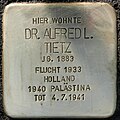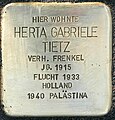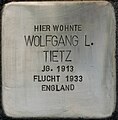Margarete Tietz
Margarete Caecilie Tietz (née Dzialoszynski, born on August 31, 1887 in Berlin ; died on February 26, 1972 in London ) was the wife of the Jewish department store owner Alfred Leonhard Tietz . She was a committed social welfare worker , educator and patron both in Cologne and after emigrating to the Netherlands and the United States .
Life
Margarete Dzialoszynski was born in Berlin in 1887 as the daughter of the Jewish wholesaler Albert Ariel Dzialoszynski from Kępno and his wife Emma Sarah Meyermann from Vilnius .
After completing the secondary school for girls , she began a pedagogical training in Berlin . Building on this, she went on to study social work . In Berlin she taught children who came from needy and financially weak backgrounds.
In 1909 she married the eldest son of the department store founder Leonhard Tietz , the Cologne merchant Alfred Leonhard Tietz. Even after her marriage, Margarete Tietz was committed to social issues. In 1912 she was elected to the board of the Association for Jewish Nurses . The first son Wolfgang was born in 1913, and daughter Herta Gabriele two years later. After the death of Leonhard Tietz, Margarete Tietz's husband took over the management of the department stores of Leonhard Tietz AG. A short time later he was drafted into military service for four years during the First World War . During the war, Margarete Tietz got involved in the Fatherland Women's Association at home and attended the College for Communal and Social Administration. As in Berlin, she also taught children from underprivileged backgrounds in Cologne.
After the First World War, the Tietz couple bought the villa built by Hervey Cotton Merrill in 1908 at Parkstrasse 61 in Cologne-Marienburg . In December 1920 the couple's youngest son, Ulrich Albert, was born.
Together with her husband, she supported numerous social projects in Cologne after the war and was actively involved in social welfare . She was temporarily chairwoman of the Sisters' Association of the Jewish Asylum , to which she had belonged since 1911, chairwoman of the Association for Maternal and Children's Rights and the Cologne Association for Women's Studies . Together with her mother-in-law Flora Tietz, she was a member of the Cologne Women's Club . In addition, she founded the summer camp for working women and was a co-founder of the Cologne family service . At times she headed the Jewish Women's Association in Cologne, the sister association of the Rhineland and Moriahloge and the Jewish people's kitchen founded in 1919 .
In 1925 Margarete Tietz was one of the ten female members of the first day of the Prussian State Association of Jewish Communities (PLV). During the Great Depression at the beginning of the 1930s, she and family members organized food for 800 starving people in canteens every day. For a time Margarete Tietz was a member of the Social Committee of the Prussian State Association of Jewish Communities. In 1929 she was one of the co-founders of GEDOK in Cologne. In the following newspaper she sponsored numerous young artists.
Immediately after the National Socialists came to power , the Jewish shops and department stores were boycotted , loans from the banks were canceled and the owners were put under massive pressure to hand over the management to "Aryan hands". Financially cornered, on March 31, 1933 - one day before the first nationwide "boycott day" - the board of directors of Tietz AG resigned. Over the next few weeks, Leonhard Tietz was forced to sell the company well below its value. The department stores of Leonhard Tietz AG were " Aryanized " and "taken over" by Westdeutsche Kaufhof AG . Immediately before the boycotts, the Tietz family fled to Amsterdam with their children and mother-in-law Flora Tietz . The Tietz couple returned to Cologne at short notice to arrange business matters. Because of her Jewish origins, she had to give up all office in the spring of 1933. Margerete Tietz left Cologne on July 9, 1933 and went to the Saar area with her husband . In 1934 the couple also emigrated to Amsterdam. Here she was involved in the Jewish Advisory Board and in the Joodsche Vrouwencomité and founded a Club of Refugees in Amsterdam. She supported and instructed German emigrants before they emigrated to England and the United States .
Immediately before the Wehrmacht marched into Amsterdam, the Tietz family fled to Palestine in the last ship to leave . A year later, on August 4, 1941, Alfred Tietz died at the age of 58. In order to secure her livelihood, Margarete Tietz opened a guest house in Jerusalem - Talpiot . She used the proceeds to finance her daughter Herta's medical studies. After the Second World War , a return to Germany was out of the question for Margarete Tietz. In 1948 she emigrated from Palestine to the United States, originally favored by the Tietz couple, where numerous relatives and close friends of the family had settled.
She settled on the west coast of the USA. The social scientist and Quaker Hertha Kraus , who also fled from Cologne , asked Margarete Tietz to help move a nursing home for refugees from Europe from New York to Newark . As in Germany and the Netherlands, Margarete Tietz was committed to helping sick and elderly people, especially refugees and survivors of the Holocaust . She set up a social foundation in her name and took over the management of various social institutions. At New York University she deepened her knowledge in the field of gerontology . She founded the Margaret Tietz Nursing & Rehabilitation Center , in which - similar to the Riehler Heimstätten residential project designed by Hertha Kraus in Cologne - residents of different denominations live in a facility with a residential home , nursing homes and a care area for people with physical and mental disabilities could.
Margarete Tietz died on February 26, 1972 at the age of 84 while visiting London.
Honors and commemorations
Margarete Tietz was honored for her social commitment on the occasion of the 30th anniversary of the founding of the American Federation of Jews from Central Europe . In the United States, she founded the Margaret Tietz Foundation , which supported social projects for Jewish emigrants. She founded the Margaret Tietz Nursing & Rehabilitation Center in Jamaica, Queens , New York City in the mid-1960s .
At the Bocklemünd Jewish cemetery in Cologne , a plaque on the Tietz family grave commemorates the couple Margarete and Alfred L. Tietz.
On March 18, 2019 before the former home of the Tietz family, Park Road 61 in were Cologne-Marienburg of artist Gunter Demnig , the stumbling blocks in memory of Margaret Tietz and her husband Alfred (born 1913) and the three children Wolfgang Leonhard, Herta Gabriele ( born 1915) and Ulrich Albert Leonhard (born 1920). The laying of the stumbling stone was initiated by the Rhineland Cologne section of the German Alpine Club .
Stumbling block for Margarete Tietz
Individual evidence
- ↑ Barbara Becker-Jákli: The Jewish Hospital in Cologne: The History of the Israelite Asylum for the Sick and the Old Age 1869 to 1945 . Emons, Cologne 2004, ISBN 3-89705-350-0 , p. 210 .
- ↑ Wolfram Hagspiel ; Dorothea Heiermann: Cologne: Marienburg: Buildings and architects of a villa suburb - including the villa areas of Bayenthal. 2 . Bachem, Cologne 1996, ISBN 3-7616-1147-1 , p. 596 ff .
- ^ A b Irene Franken : Women in Cologne: the historical city guide . Bachem, Cologne 2008, ISBN 978-3-7616-2029-8 , pp. 276 .
- ^ A b Claudia Prestel: Women's Politics or Party Politics? Jewish women in internal Jewish politics in the Weimar Republic . In: Archives for Social History . tape 37 , 1997, pp. 137 .
- ↑ Barbara Becker-Jákli: The Jewish hospital in Cologne: the history of the Israelite asylum for the sick and the elderly from 1869 to 1945 . Emons, Cologne 2004, ISBN 3-89705-350-0 , p. 464 f .
- ^ Barbara Becker-Jákli: The Jewish Cologne past and present . Emons, Cologne 2012, ISBN 978-3-89705-873-6 , p. 147 .
- ↑ Joseph Walk (ed.): Short biographies on the history of the Jews 1918–1945. Edited by the Leo Baeck Institute, Jerusalem. Saur, Munich 1988, ISBN 3-598-10477-4 , p. 366.
- ^ Britta Bopf: "Aryanization" in Cologne: The economic destruction of the existence of the Jews 1933-1945 . Ed .: NS Documentation Center of the City of Cologne. Emons, Cologne 2004, ISBN 3-89705-311-X , p. 88 .
- ^ Sibylle Quack: Between sorrow and strength: women refugees of the Nazi period . Cambridge University Press, Cambridge 2002, ISBN 0-521-52285-4 , pp. 114 f .
- ↑ a b Margarethe Tietz - FrauenGeschichtsWiki. Retrieved February 24, 2019 .
- ^ Sibylle Quack: Between sorrow and strength: women refugees of the Nazi period . Cambridge University Press, Cambridge 2002, ISBN 0-521-52285-4 , pp. 189 .
- ↑ a b In Memoriam: Mrs. Margaret Tietz . In: AJR Information . tape XXVII , no. 4 . London April 1972, p. 11 .
- ^ Barbara Becker-Jákli: The Jewish cemetery in Cologne-Bocklemünd: history, architecture and biographies . Ed .: NS Documentation Center of the City of Cologne. emons, Cologne 2016, ISBN 978-3-95451-889-0 , p. 82 f .
- ↑ dav-koeln.de: German Alpine Association - Fourth Stumbling Stone Laying for Former Jewish Members , accessed on March 24, 2019
Web links
| personal data | |
|---|---|
| SURNAME | Tietz, Margarete |
| ALTERNATIVE NAMES | Dzialoszynski, Margarete Caecilie (maiden name); Tietz, Margarete Caecilie (married name); Tietz, Margret (after emigration) |
| BRIEF DESCRIPTION | German-American social welfare worker, educator and patron |
| DATE OF BIRTH | August 31, 1887 |
| PLACE OF BIRTH | Berlin |
| DATE OF DEATH | February 26, 1972 |
| Place of death | London |





